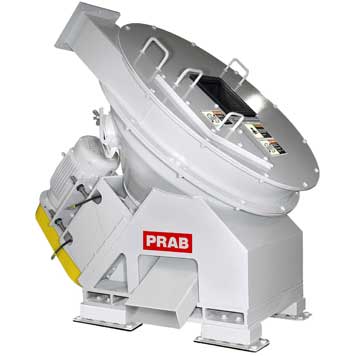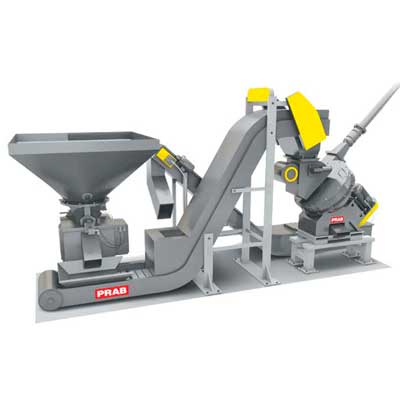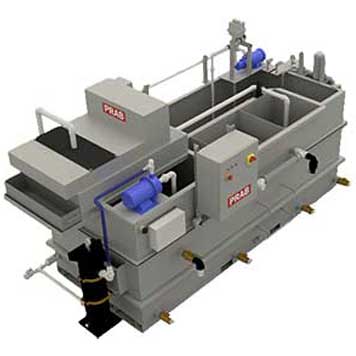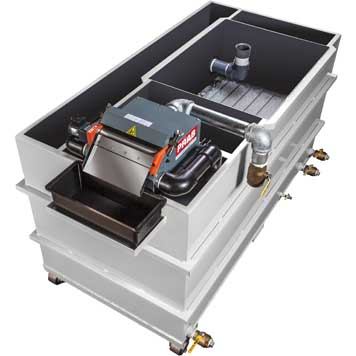
Hazardous metal scrap and fluid waste creates many problems in metalworking: health and safety issues, misused floor space and labor resources, poor housekeeping practices, high expenses, and unrealized revenue. While many of these problems are also true for non-hazardous metalworking waste, if hazardous waste is not managed properly, metalworking operations may also face regulatory compliance consequences.
Any hazardous metalworking byproducts must be handled and disposed of in accordance with specific management requirements that depend on the amount of hazardous waste the operation produces.
The U.S. Environmental Protection Agency (EPA) determines a waste to be a hazardous waste if it is specifically listed on one of four lists (the F, K, P, and U lists) found in Title 40 of the Code of Federal Regulations (CFR) in section 261.1 The F-list identifies hazardous wastes from common manufacturing and industrial processes. Spent solvents, electroplating, and other metal finishing wastes are included in this list.
Furthermore, the EPA categorizes producers of hazardous waste according to the following designations:
Some states may set different quantity limits for hazardous waste. Check with your state for a complete list of requirements for hazardous waste generators.3
When metal scrap is coated with cutting fluid, it compounds hazardous waste handling requirements by increasing the total amount of potentially hazardous material that needs to be managed. This results in wasted storage space, and higher labor costs, haul-away fees, and fluid purchases. Some of the typical metalworking hazardous waste generated include solvents and degreasers, cutting fluids, lubricants, paint waste, and wastewater pretreatment sludges. Depending on the metal type and cooling lubricant used, swarf, shavings, grinding fines, and other metal waste could also be considered hazardous. These materials may also contribute to health and safety problems, especially if the cutting fluid has deteriorated significantly.
If your facility is facing compliance consequences due to cutting fluid leaking into the environment, or is experiencing high haul-away costs, there are two process enhancements that have been proven to be very effective: separating cutting fluids from metal scrap and utilizing fluid filtration technologies to extend the life of metalworking fluids.
Separating cutting fluids from metal scrap provides several hazardous waste cost-saving benefits. It reduces the total weight of scrap material that needs to be hauled away and it creates the opportunity to recycle and reuse cutting fluids. Dry metal scrap also earns a higher value—up to 25% higher—from metal scrap recyclers. Reducing the volume of scrap metal and separating fluids prior to recycling also reduces the amount of space and/or containers needed to store the metal scrap, helps keep the facility clean, and decreases safety hazards.
Automated equipment solutions that separate metal scrap and cutting fluids include:

Uses centrifugal force to spin metal chips to remove the fluid. The fluid drains away from the chips—up to 98% of cutting fluids can be reclaimed for recycling and reuse, which will reduce new fluid purchases. Wringers can handle various types of metal, including aluminum, brass, cast iron, steel, stainless steel, and more.

These systems incorporate a preconditioning step that prepares the metal scrap prior to the scrap being wrung in a centrifuge. Crushers are used to reduce the volume of turnings and bundles. Shredders are used to reduce the volume of loose metal turnings to create flowable chips. Tramp metal separators also may be utilized to remove bar ends and other tramp metals. After the metal scrap is pre-conditioned, a wringer is used to efficiently remove moisture from the metal.
Using fluid filtration to extend the life of cutting fluids is another way to reduce the total volume of hazardous waste that needs to be safely stored, hauled away, and treated. Fluid filtration systems are shown to reduce hazardous waste volumes by as much as 90%. They can also lower new fluid purchases by 75%. By controlling bacteria levels in the fluid to help prevent dermatitis, employee health and safety is also improved. Automated systems that extend the life of cutting fluids also significantly reduce manual labor required to maintain sumps and fluid quality. Examples of these systems include:

Automatically removes tramp oils and suspended solids from contaminated coolant, controlling bacteria and adjusting fluid concentration for fluid recovery.

Automatically removes free-floating and mechanically dispersed tramp oils, bacteria, slime, inverted emulsions, and more from individual machine sumps, central systems, and wash tanks.

While hazardous waste will always first need to be viewed as an environmental and safety issue, it is also a recurring operational expense for metalworking operations. Moreover, facilities that enhance their processes to improve hazardous waste-handling practices will position their operation to realize lower labor, fluid, and haul-aways costs, as well as potentially higher revenue from recyclers. Improvements such as these are a way to not only take control of compliance concerns once and for all, but to create sustainable savings that will benefit the operation year after year.

Mike Hook is the Sales & Marketing Director for PRAB and has more than 15 years of mechanical design and application experience. PRAB is a leading manufacturer of engineered conveyors and equipment for processing turnings, chips, and metalworking fluids. PRAB also designs and builds industrial wastewater recycling systems.
1 The U.S. Environmental Protection Agency, “Defining Hazardous Waste: Listed, Characteristic and Mixed Radiological Wastes,” March 2021, https://www.epa.gov/hw/defining-hazardous-waste-listed-characteristic-and-mixed-radiological-wastes#characteristic
2 The U.S. Environmental Protection Agency, “Categories of Hazardous Waste Generators,” March 2021, https://www.epa.gov/hwgenerators/table-noting-which-states-have-hazardous-waste-generator-categories-are-same-federal
3 The U.S. Environmental Protection Agency, “Table Noting Which States Have Hazardous Waste Generator Categories That Are the Same as the Federal Categories and Which Have Different Categories,” March 2021, https://www.epa.gov/hwgenerators/table-noting-which-states-have-hazardous-waste-generator-categories-are-same-federal